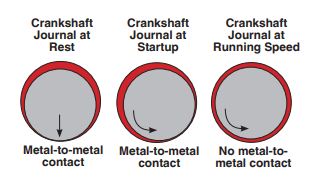Engine start-stop technology can increase bearing wear
Use only the best quality oil in these engines as the crankshaft needs to float. Even the “so called synthetics” don’t dampen the metal to metal issues mentioned below nearly as well as AMSOIL and you can tell due to the reduction in vibration or more consistent oil pressure as you rack up miles.
Yet another reason to upgrade to AMSOIL synthetic motor oil.
Matt Erickson | DIRECTOR, TECHNICAL PRODUCT MANAGEMENT
Nearly every technology shaping the auto industry can be traced to one goal: increased fuel economy. Engine start-stop technology is one more tool automakers have in their arsenals to ensure today’s vehicles meet tomorrow’s tightening fuel-economy regulations.
In principle, start-stop technology is simple: the engine automatically shuts off while you’re idling and restarts when you take your foot off the brake. This reduces fuel wasted while idling. Automakers introduced different startstop systems in the late ‘70s and early ‘80s; however, drivers found them awkward and unworthy of the higher vehicle price. Today’s start-stop systems are less obtrusive and are available on vehicle models from most automakers.
Should be called Metal to Metal Contact Engine
That’s not to say they’re without detractors. In fact, some automakers have installed off switches that allow motorists to disable the feature in response to negative driver feedback. But, despite their pitfalls, they’re likely not going anywhere. Consider these statistics:
- According to bearing manufacturer MAHLE*, U.S. vehicles burned 3.9 billion gallons of gasoline while idling in 2017.
- Buick* reports that engines with start-stop technology increase fuel economy 4-5 percent using the EPA test cycle.
Automakers leap for joy over minuscule fuel-economy gains, so you can bet they’re going to stick with anything that may provide a 4-5 percent boost.
So, what does that have to do with motor oil?
Maybe you’re aware that most engine wear occurs during cold starts. Well, engine wear occurs during warm starts, too, like every time an engine equipped with start-stop technology restarts.
We have to get technical to understand why.
The crankshaft spins thousands of times per minute in a running engine. As it spins, oil flows through tiny openings in the crankshaft journals and fills the spaces between the journals and main bearings. The crankshaft literally floats on an oil film and doesn’t contact the bearings. We call this scenario hydrodynamic lubrication. In this regime, the bearings suffer little wear and last a long time.
Run of the mill oils (95% on the shelf) are not going to provide protection with this condition
Stopping the engine, however, reduces oil film thickness. The crankshaft settles onto the bearing surfaces rather than floats over them. The oil film thickness shrinks to about the same thickness as the surface roughness of the crankshaft. This is called boundary lubrication. Starting the engine allows the microscopic peaks on the metal surfaces to contact and cause wear until the oil film has been reestablished and the crankshaft is once again floating over the bearings. This is where the oil’s additives play a huge role in protection.
Granted, only minimal wear may occur each time the engine is started. It’s not a big concern in a properly maintained traditional engine using a good oil. But what if you greatly increase engine startstop cycles?
Consider another statistic from MAHLE:
- Start-stop cycles in equipped engines may triple over the engine’s lifetime compared to traditional engines.
That means three times more engine starts, three times more instances of boundary lubrication and three times more exposure to increased bearing wear.
Bearing wear can snowball out of control, too. Metal particles can break off and populate the oil. The bearing surface becomes rougher, encouraging adhesive wear in which peaks on metal surfaces grab and tear the mating surfaces. Eventually the crank journal and bearing can weld together, ruining the bearing.
This all points to a simple directive: make sure your customers with engines using start-stop technology are using AMSOIL synthetic motor oil to guard against bearing wear. Oil film thickness shrinks when engines start from a dead stop, placing even more importance on oil additives to maintain protection. Since engines equipped with start-stop technology spend so much more time under boundary lubrication, it’s vital to use an oil with superior film strength and additive quality. AMSOIL Signature Series Synthetic Motor Oil delivers. It provides 75% more engine protection against horsepower loss and wear** to help protect today’s advanced engines.
This is especially needed in vehicles calling for 0W-20, 5W-20 and 0W-16.


